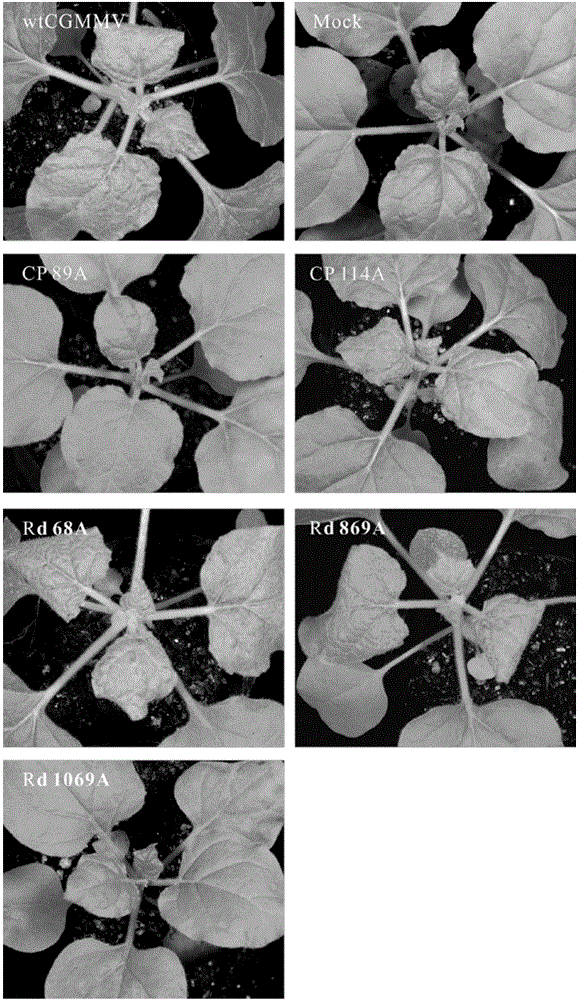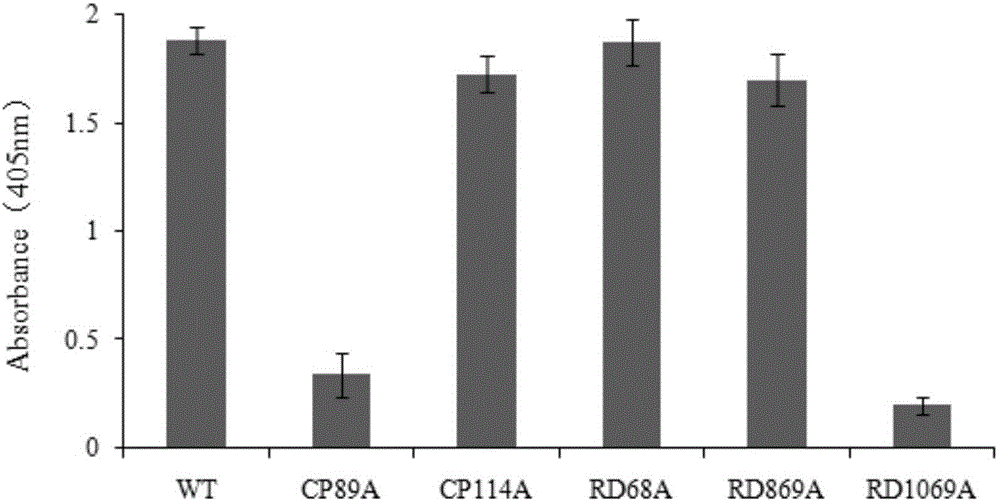Selection of cucumber green mottle mosaic virus low virulent strain line and application of cucumber green mottle mosaic virus low virulent strain line in cross protection
A technology of green mottled flowers and attenuated strains, applied in applications, viruses, viral peptides, etc., can solve problems such as few researches
- Summary
- Abstract
- Description
- Claims
- Application Information
AI Technical Summary
Problems solved by technology
Method used
Image
Examples
Embodiment 1
[0023] Example 1: Site-directed mutagenesis
[0024] Using the infectious clone pCaCGMMV of cucumber green mottle mosaic virus as a template, the five sites were mutated by PCR, and the polymerase used was Phusion high-fidelity polymerase (Finnzymes).
[0025] The PCR reaction system is as follows:
[0026]
[0027] After the reaction, add 0.5 μL Dpn I (20 U / μL) to the PCR product, treat at 37°C for 2 hours, add 125 μL absolute ethanol and 5 μL 3mol / L sodium acetate (pH=5.2), mix well, and precipitate overnight at -20°C. Centrifuge at 13000r / min for 10min, discard the supernatant, wash the pellet with 1mL of 75% ethanol and dry it at room temperature, add 10μL of ddH 2 Redissolve in O water, transform Escherichia coli stbl3, and verify the mutant plasmid by sequencing.
Embodiment 2
[0028] Example 2: Virus inoculation
[0029] Transform pCaCGMMV or the mutant plasmid into Agrobacterium GV3101. After colony PCR verification, pick a single spot and inoculate it in liquid LB medium containing kanamycin (50 μg / mL), rifamycin (50 μg / mL), and tetracycline (50 μg / mL). Add 500 μL of bacterial liquid to 5 mL of LB medium containing 10 mmol / L 2-(N-morpholine)-ethanesulfonic acid (MES), 20 μmol / L acetosyringone (AS) and the above three antibiotics, at 28 °C Shake culture to logarithmic growth phase. Collect the bacteria by centrifugation and resuspend in 10mmol / L MgCl 2 , 10mmol / L MES, 150μmol / L AS, adjust the concentration to make it OD 600 It is about 0.5, and it is allowed to stand at room temperature for 3 hours. Take a 5mL disposable syringe, remove the needle to absorb the Agrobacterium liquid, and infiltrate it from the back of the leaves of Nicotiana benthamiana (5-6 weeks old or 4-6 true leaves). Infiltrate 2 leaves per plant. The infiltrated plants w...
Embodiment 3
[0030] Embodiment 3: Symptom observation and virus concentration detection
[0031] The symptoms of the inoculated plants were observed, and the accumulation levels of virus genes and proteins were detected by fluorescent quantitative PCR and ELISA. On the 10th day after inoculation, the wild-type virus and the mutants CP114A, Rd68A, and Rd869A caused obvious symptoms such as mosaic and mottle on the leaves of Nicotiana benthamiana system, while the 89th position of the capsid protein and the replicase RdRp The 1069 mutant showed almost no symptoms on Nicotiana benthamiana ( figure 1 ). The inventors named these attenuated mutants as CP89A and Rd1069A respectively (the nucleotide sequence of the CP gene of CP89A is shown in Seq ID No.15, the amino acid sequence of its CP is shown in Seq ID No.17; the nucleotide sequence of the RdRp gene of Rd1069A is shown in Seq ID No.16, its RdRp amino acid sequence is shown in Seq ID No.18). Fluorescent quantitative PCR detection results...
PUM
 Login to View More
Login to View More Abstract
Description
Claims
Application Information
 Login to View More
Login to View More - R&D
- Intellectual Property
- Life Sciences
- Materials
- Tech Scout
- Unparalleled Data Quality
- Higher Quality Content
- 60% Fewer Hallucinations
Browse by: Latest US Patents, China's latest patents, Technical Efficacy Thesaurus, Application Domain, Technology Topic, Popular Technical Reports.
© 2025 PatSnap. All rights reserved.Legal|Privacy policy|Modern Slavery Act Transparency Statement|Sitemap|About US| Contact US: help@patsnap.com



